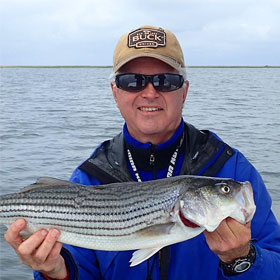What You Should Know About Balancing a Fishing Rod
By Ken Schultz
Apr 10, 2019
The topic of balancing a fishing rod involves both how to tell if a rod and reel are matched properly, and how to change the balance point with added weight
When looking at a new rod, reel, or rod-and-reel package, the subject of balancing a fishing rod comes up while pairing these two essential fishing gear components. The topic of balancing a fishing rod, or balanced tackle in general, actually comprises two different issues.
1. Matching Rod and Reel
The first is the question of how to properly match a specific rod with a specific reel. People often refer to having the right reel for a certain rod as “balanced tackle,” when they really mean matching these products properly so that the resulting package is comfortable to use and helps achieve the necessary casting, retrieving, strike detecting, and hooksetting functions.
This term means that the rod and reel should complement each other and be suited for use together. You wouldn't use a small ultralight reel with a medium-action rod. Nor would you use a big reel capable of holding 200 yards of 12-pound line with a light rod meant for 4- to 8-pound line. Filling that big reel with 6-pound line isn't a solution either, because it isn't so designed, and you'd still have a reel that is too large for comfortable use with that particular rod.
When the rod and reel are matched properly, the rod should be neither too heavy in the tip section nor too heavy in the handle. If a reel is too heavy or too light for a particular rod, casting distance and accuracy will be impaired, as will strike detection. This is especially true with spinning gear.
To see if the rod and reel are properly balanced, select a rod first, then match the reel to it. Using a spinning rod as an example, with a reel mounted on the rod (no lure tied on), hold the rod with the reel stem between your small finger and ring finger, or with the reel stem between your ring finger and middle finger. Choose whichever is most comfortable to you. If the outfit is balanced, in the former example the balance point will be where the middle finger touches the rod handle, and in the latter example the balance point will be where the index finger touches the rod handle.
If the rod is properly balanced, you’ll be able to hold the rod with one finger at the balance point and the rod will stay level, not tipping in either direction. This will hold true for the general range of spinning tackle, excepting heavy outfits.
Incidentally, some manufacturers offer rod-and-reel combinations in which they’ve matched the rod and reel for suitability with each other, so you don’t have to fuss over balancing a fishing rod. These are generally well balanced and priced at a discount to purchasing the components separately.
2. Adding Weight to the Rod
The second issue in the subject of balancing a fishing rod has to do with modifying a rod in order to change the balance point. This may be desirable depending on your fishing method. Some lures, like worms and jigs, are fished with the rod tip up, and balance is especially critical on the retrieve for strike detection. Others, like crankbaits and spinnerbaits, are fished with the tip down, and balance is not as critical while retrieving. This is why many rods are designed for specific applications.
That said, if you have a rod that is tip heavy with the reel it’s matched to (the tip falls down when you hold it at the balance point), or you want to cast heavy lures/weights further, you can do so by adding weight to the bottom of the rod. This moves the balance point further down the rod handle.
One method of accomplishing this is to place from one to four quarters at the bottom of a butt cap that is then pressed over the end of the rod handle. Make sure that the butt cap fits snugly. Another method is to buy a rod-balancing kit comprised of weights and a butt cap. Place one or more of the weights in the cap and put that over the rod butt.
When you’re considering how to balance a fishing rod, realize that what works, or feels comfortable, for one person may not work for another due to differences in hand size, hand strength, the way each holds a fishing outfit, and other reasons. You have to find what’s best for you.
Don't forget to buy your fishing license before planning you next fishing adventure!









